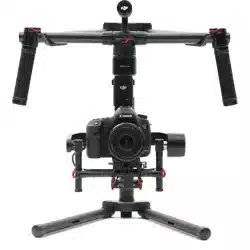Loading ...
Loading ...
Loading ...

Ronin-M
User Manual
18
©
2015 DJI. All Rights Reserved.
1. Motor Adjustment
The Auto Tune Stability button allows for automatic adjustment of each motor’s stiffness (as relayed from the
sensors and interpreted by the Ronin-M) to accomplish an optimized setting. Besides the stiffness, there
are other electronic settings being tuned. It is highly recommended that the Auto Tune Stability button be
tapped whenever a new camera conguration is mounted or the lens or accessories are changed. This will
offer the optimal stability and settings.
Each axis has its own stiffness and trim adjustment. The motor stiffness adjustment allows the user to ne
tune the amount of power that is applied by the motors as they react and balance the weight on each axis.
The higher you adjust the stiffness settings, without causing any vibrations or oscillations to the gimbal, the
better your experience will be. In most cases, the Auto Tune Stability settings will be suitable.
2. SmoothTrack Mode
Refer to the Basic Settings section for details relating to SmoothTrack Mode.
3. Push Mode
Enable Push Mode to allow the pan and tilt axes to be adjusted by hand when the Ronin-M is turned on.
Control Menu
1. Deadband
The thumb controller and the remote operator control can have independently adjusted pan and tilt
deadband settings. The larger the deadband, the more stick movement will be required to translate
into actual movement of the gimbal.
Gimbal Control Viewer More
N/A
Mode:
Wizard
Control
Deadband Maximum Speed
Smoothing Endpoint
Channels Settings
?
Gimbal Control Viewer More
Deadband Adjustment
Thumb
Controller
Remote
Operator
Pan
Tilt
Control
Deadband
6
6
6
6
?
Gimbal Control Viewer More
Control Speed Adjustment
Thumb
Controller
Remote
Operator
Pan
Tilt
Control
Maximum Speed
40
15
15
15
2. Maximum Speed
Maximum Speed is a function that prevents the control stick response from being a linear response,
which is also known as an increasing response curve. This means the amount that the gimbal moves
on the pan or tilt axis is not directly proportional to control stick manipulation. Control stick response
can be adjusted to be milder below the first half of control stick travel and increased to a higher
speed towards the last half of control stick travel. The preset exponential curve is calibrated based on
maximum speed input. The maximum speeds of the thumb controller and the remote control sticks
can be set independent of each other.
DJI Ronin-M Assistant App Tuning
Loading ...
Loading ...
Loading ...
